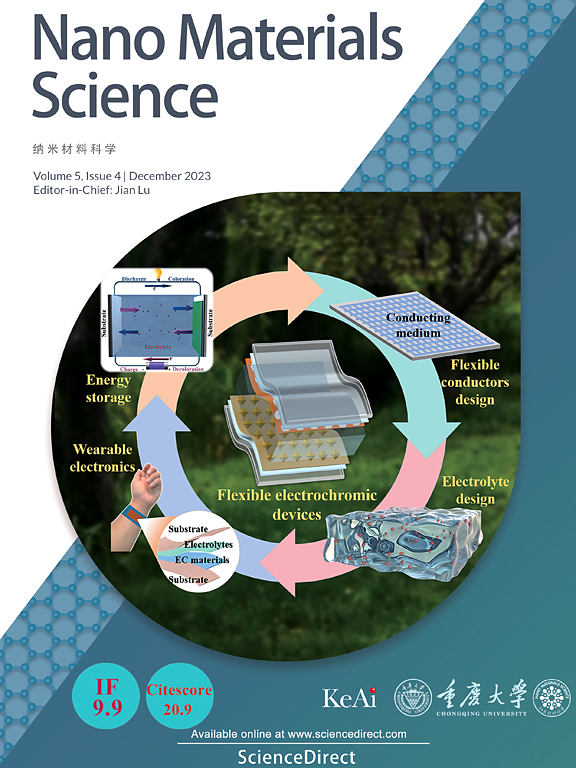Facile and adjustable production of self–standing oxygen–doped graphene membranes for optimized oxygen evolution electrocatalysis
IF 17.9
2区 材料科学
Q1 Engineering
引用次数: 0
Abstract
Owing to abundant resource and affordable price, metal–free carbon has been extensively studied in the field of oxygen reduction reaction, while the related studies on oxygen evolution reaction (OER) are quite few. In this work, a facile and scalable knife coating coupled with annealing strategy is proposed to produce self–standing oxygen–doped graphene membranes (marked as O–GM–T, T represents the annealing temperature). Through systematic characterization and analysis, it is discovered the annealing treatment not only decreases the amount of oxygenic groups, but allows for controlled regulation of the oxygen configurations, leaving only C–OH/C–O–C and C![]() O. Meanwhile, theoretical calculations indicate that the OER activity trend of different oxygen configurations is as follows: –COOH > C
O. Meanwhile, theoretical calculations indicate that the OER activity trend of different oxygen configurations is as follows: –COOH > C![]() O ≈ C–OH > C–O–C. Despite the removal of highly active –COOH group through annealing treatment, the resulting O–GM–800 sample maintains good mechanical property and achieves a favorable balance on conductivity, hydrophilicity and catalytic sites. Consequently, it displays significantly improved OER performance compared to the counterparts, making it highly promising for applications in overall water splitting devices. Apparently, our work provides guidance for the rational design and controllable fabrication of self–standing carbon–based catalysts for energy–related reactions.
O ≈ C–OH > C–O–C. Despite the removal of highly active –COOH group through annealing treatment, the resulting O–GM–800 sample maintains good mechanical property and achieves a favorable balance on conductivity, hydrophilicity and catalytic sites. Consequently, it displays significantly improved OER performance compared to the counterparts, making it highly promising for applications in overall water splitting devices. Apparently, our work provides guidance for the rational design and controllable fabrication of self–standing carbon–based catalysts for energy–related reactions.
为优化氧进化电催化而方便、可调地生产自立式掺氧石墨烯膜
由于资源丰富、价格实惠,无金属碳在氧还原反应领域得到了广泛的研究,而在析氧反应(OER)方面的相关研究却很少。在这项工作中,提出了一种简单可扩展的刀涂结合退火策略来生产自给式掺氧石墨烯膜(标记为O-GM-T, T代表退火温度)。通过系统的表征和分析,发现退火处理不仅减少了含氧基团的数量,而且可以对氧构型进行可控调节,只留下C-OH / C-O-C和CO。同时,理论计算表明,不同氧构型的OER活度趋势如下:-COOH >;CO≈C-OH >;C-O-C。尽管通过退火处理去除了高活性的-COOH基团,但得到的O-GM-800样品保持了良好的力学性能,并在电导率、亲水性和催化位点上取得了良好的平衡。因此,与同类产品相比,它显示出显着改善的OER性能,使其在整体水分解装置中的应用具有很大的前景。显然,我们的工作为合理设计和可控制造用于能源相关反应的自立型碳基催化剂提供了指导。
本文章由计算机程序翻译,如有差异,请以英文原文为准。
求助全文
约1分钟内获得全文
求助全文
来源期刊

Nano Materials Science
Engineering-Mechanics of Materials
CiteScore
20.90
自引率
3.00%
发文量
294
审稿时长
9 weeks
期刊介绍:
Nano Materials Science (NMS) is an international and interdisciplinary, open access, scholarly journal. NMS publishes peer-reviewed original articles and reviews on nanoscale material science and nanometer devices, with topics encompassing preparation and processing; high-throughput characterization; material performance evaluation and application of material characteristics such as the microstructure and properties of one-dimensional, two-dimensional, and three-dimensional nanostructured and nanofunctional materials; design, preparation, and processing techniques; and performance evaluation technology and nanometer device applications.
 求助内容:
求助内容: 应助结果提醒方式:
应助结果提醒方式:


